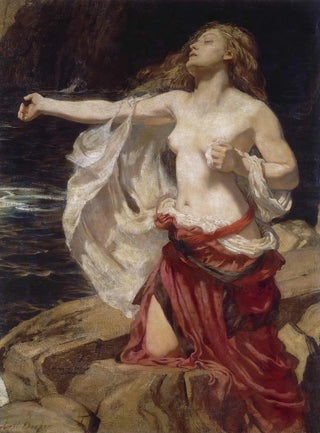Art print | Ariane - Herbert James Draper


View from behind

Frame (optional)
Ariane Art print - Herbert James Draper – Captivating Introduction
The artwork "Ariane" by Herbert James Draper is an invitation to immerse oneself in a universe where mythology meets sensuality and early 20th-century aesthetics. This painting, which vividly evokes the legend of Ariane, an iconic figure of Greek mythology, depicts the moment when the young woman, abandoned on the island of Naxos by Theseus, finds herself at a crossroads between despair and hope. Draper, with his unparalleled talent, succeeds in capturing the essence of this tragic heroine, enveloping the viewer in an atmosphere that is both melancholic and enchanting. Every brushstroke tells a story, every color evokes an emotion, and the entire composition transports us to the heart of a timeless epic.
Style and uniqueness of the artwork
Draper's style is characterized by remarkable finesse in the treatment of forms and colors. "Ariane" stands out with a rich and nuanced palette, where warm and golden hues intertwine with delicate shadows, creating a striking depth. The artist masters the art of chiaroscuro, skillfully playing with light to highlight the sculptural beauty of Ariane's body. The drapery of her garment, which seems almost alive, reveals a deep understanding of human anatomy and movement. This artwork does not merely depict a mythological scene; it transcends the simple narrative to become a celebration of feminine beauty and human vulnerability. Ariane's gaze, both lost and determined, captivates and challenges, making this canvas a true masterpiece of symbolist art.
The artist and his influence
Herbert James Draper, a British painter of the late 19th and early 20th centuries, established himself as one of the most influential artists of his time. Raised in an artistic environment, he was trained at the Royal Academy of Arts and was heavily influenced by the Pre-Raphaelites and the Symbolist movement. His technique, blending realism and idealization, paved the way for new interpretations

Matte finish

View from behind

Frame (optional)
Ariane Art print - Herbert James Draper – Captivating Introduction
The artwork "Ariane" by Herbert James Draper is an invitation to immerse oneself in a universe where mythology meets sensuality and early 20th-century aesthetics. This painting, which vividly evokes the legend of Ariane, an iconic figure of Greek mythology, depicts the moment when the young woman, abandoned on the island of Naxos by Theseus, finds herself at a crossroads between despair and hope. Draper, with his unparalleled talent, succeeds in capturing the essence of this tragic heroine, enveloping the viewer in an atmosphere that is both melancholic and enchanting. Every brushstroke tells a story, every color evokes an emotion, and the entire composition transports us to the heart of a timeless epic.
Style and uniqueness of the artwork
Draper's style is characterized by remarkable finesse in the treatment of forms and colors. "Ariane" stands out with a rich and nuanced palette, where warm and golden hues intertwine with delicate shadows, creating a striking depth. The artist masters the art of chiaroscuro, skillfully playing with light to highlight the sculptural beauty of Ariane's body. The drapery of her garment, which seems almost alive, reveals a deep understanding of human anatomy and movement. This artwork does not merely depict a mythological scene; it transcends the simple narrative to become a celebration of feminine beauty and human vulnerability. Ariane's gaze, both lost and determined, captivates and challenges, making this canvas a true masterpiece of symbolist art.
The artist and his influence
Herbert James Draper, a British painter of the late 19th and early 20th centuries, established himself as one of the most influential artists of his time. Raised in an artistic environment, he was trained at the Royal Academy of Arts and was heavily influenced by the Pre-Raphaelites and the Symbolist movement. His technique, blending realism and idealization, paved the way for new interpretations






